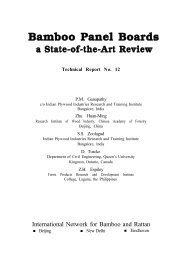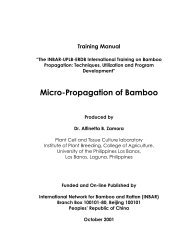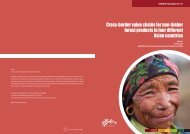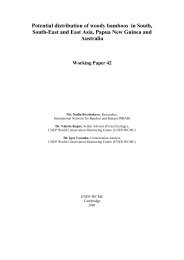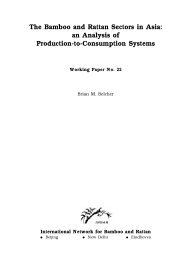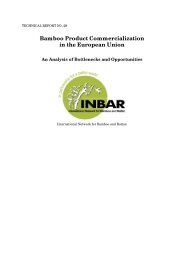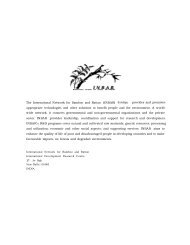ISSN ………… - International Network for Bamboo and Rattan
ISSN ………… - International Network for Bamboo and Rattan
ISSN ………… - International Network for Bamboo and Rattan
Create successful ePaper yourself
Turn your PDF publications into a flip-book with our unique Google optimized e-Paper software.
4.5.2. Sizing<br />
Sizing has been described as the treatment given to paper to prevent aqueous solutions, such as ink,<br />
from soaking into it. A typical sizing solution consists of a rosin soap dispersion mixed with the stock<br />
in an amount of 1-5 per cent of fibre. Since there is no affinity between rosin soap <strong>and</strong> fibre, it is<br />
necessary to use a coupling agent, normally alum (aluminium sulphate). The acidity of alum<br />
precipitates the rosin dispersion, <strong>and</strong> the positively charged aluminium ions <strong>and</strong> aluminium hydroxide<br />
flocs (masses of finally suspended particles) attach the size firmly to the negatively charged fibre<br />
surface.<br />
Paper intended <strong>for</strong> writing or printing usually contains white pigments or fillers to increase<br />
brightness, opacity <strong>and</strong> surface smoothness, <strong>and</strong> to improve ink receptivity. Clay (aluminium silicate),<br />
often referred as kaolin or china clay, is commonly used. Another pigment used as filler is titanium<br />
dioxide, which being expensive, is often used in admixture with others. Calcium carbonate is also<br />
used as paper filler <strong>for</strong> printing <strong>and</strong> magazine stocks <strong>and</strong> <strong>for</strong> the filling of cigarette paper, to which it<br />
contributes good burning properties. Because of its reactivity with acid, calcium carbonate cannot be<br />
used in systems containing alum. Other fillers such as zinc oxide, zinc sulphide, hydrated silica,<br />
calcium sulphate, hydrated alumina, talc, barium sulphate <strong>and</strong> asbestos are also in use as fillers in<br />
paper coatings. The amount of filler used may vary from 1- 10 per cent of the fibre.<br />
The most common way to impart colour to paper is to add soluble dyes or coloured pigments to the<br />
paper stock. Other additives such as wet-strength agents (organic resins), deflocculating agents <strong>and</strong><br />
de<strong>for</strong>mers are also incorporated as needed in the stock. To increase the dry strength of paper, the<br />
materials most commonly used are starch, polyacrylamide resins, <strong>and</strong> natural gums such as locust<br />
bean gum <strong>and</strong> guar gum.<br />
4.5.3. Paper sheet <strong>for</strong>mation by machines<br />
The term paper is traditionally applied to a matted or felted sheet of cellulose fibres, <strong>for</strong>med on a fine<br />
wire screen from a dilute water suspension, <strong>and</strong> bonded together as the wire removed <strong>and</strong> the sheet is<br />
dried. The word, paper, is derived from the name of the reedy plant papyrus, which grows abundantly<br />
along the Nile River in Egypt.<br />
The continuous paper machine converts a very dilute aqueous suspension of fibres <strong>and</strong> other<br />
ingredients into a dry sheet of paper at varying speeds. The fourdrinier machine is one of the two<br />
major sheet <strong>for</strong>ming devices in widespread use. It consists in essence of a continuously moving wire<br />
belt or screen, to which the dilute pulp slurry is fed <strong>and</strong> from which the wet, <strong>for</strong>med sheet is removed<br />
27



